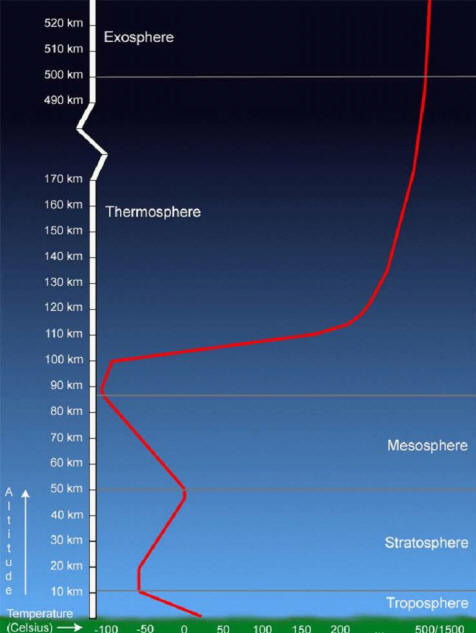TIMED is on My Side (Yes it is)
Dec
21, 2009
New research confirms that
Earth's upper atmosphere is cooling
off.
On December 7, 2001, NASA
launched the
Thermosphere, Ionosphere,
Mesosphere, Energetics and Dynamics
(TIMED)
satellite to study the upper layers
of Earth's atmosphere. As part of
the Solar Terrestrial Probes
Missions, TIMED preceded
STEREO (Solar TErrestrial
RElations Observatory), launched
October 25, 2006, and the
HINODE (Solar-B) mission,
launched September 23, 2006.
Future additions to the fleet of
space vehicles analyzing the
connection between the Sun and our
planet's environment will include
the
MMS
(Magnetosphereic MultiScale)
mission, scheduled for launch in
2014, the
GEC (Geospace
Electrodynamic Connections) mission,
and the
MagCON (Magnetospheric
Constellation) mission. The latter
two are currently in the budget
assignment and contract phase.
The highest levels of our
atmosphere are poorly understood,
especially the thermosphere. At an
altitude between 60 and 180
kilometers, it is the region where
the Sun's energy begins to interact
with atmospheric particles. Just how
this dynamic relationship proceeds
is still under investigation, but
according to a recent press release
from the the University Corporation
for Atmospheric Research (UCAR),
the thermosphere has experienced a
tenfold decline in temperature since
2002.
TIMED measurements indicate that
the amount of ultraviolet radiation
emitted by the Sun has significantly
decreased since the start of solar
minimum. The amount of infrared
radiation emitted by nitric oxide
molecules has also declined,
implying that the upper atmosphere
has cooled.
It has long been known that
temperatures in the thermosphere are
dependent on solar radiation.
Extreme ultraviolet light is
absorbed by the residual oxygen and
becomes electrically charged, with
increasing molecular motion. Fast
molecular motion is known as heat,
so even though a household
thermometer would register
temperatures below zero in the
thermosphere, it is considered hot,
sometimes reaching over 1500º
Celsius during
solar maximum.
Since there are fewer molecules
in the thermosphere, the amount of
thermal energy per cubic centimeter
is lower than it is at the
surface—there is not enough contact
between molecules to transfer heat.
The Sun's 22 year cycle has now
been shown to be linked with Earth's
climate. Although solar energy does
vary over the course of a sunspot
cycle, that variance amounts to less
than one-tenth of one percent, so
how are the increases and decreases
in thunderstorm activity explained?
Earth is an electrically charged
body that interacts with ions
permeating space. Electricity from
space is also injected into the
thermosphere from charged particles
emitted by the Sun, speeding along
massive Birkeland currents through a
closed circuit. When solar winds are
at a minimum, the electric currents
decline in amperage, thereby
decreasing the strength of our
planet's magnetosphere.
As the magnetosphere declines in
strength, it is less able to deflect
energetic ions arriving from deep
space known as cosmic rays. Cosmic
rays are charge carriers, and those
ions are able to reach the
troposphere. Collisions between
charged and neutral particles drag
air molecules along with them
influencing low level cloud cover.
More clouds reflect more radiation
from the Sun back to space—clouds
are white because they are acting
like mirrors to all forms of visible
light. More reflection means less
solar energy, more cloud cover, and
so on.
The correspondence between the
Sun's electric field strength,
cosmic rays, Earth's magnetosphere,
cloud cover, and climate are
continuing to be investigated.
Electric Universe advocates insist
that there should be more funding
devoted to understanding the
connection between Earth and our
primary.
"The knowledge gained since 1896,
in radio-activity has favoured the
view to which I gave expression in
that year, namely, that magnetic
disturbances on the earth, and
aurora borealis, are due to
corpuscular rays emitted by the
Sun."
---
Kristian Birkeland "The
Norwegian Aurora Polaris Expedition
1902-1903, Volume 1, Part 1"
Stephen Smith







